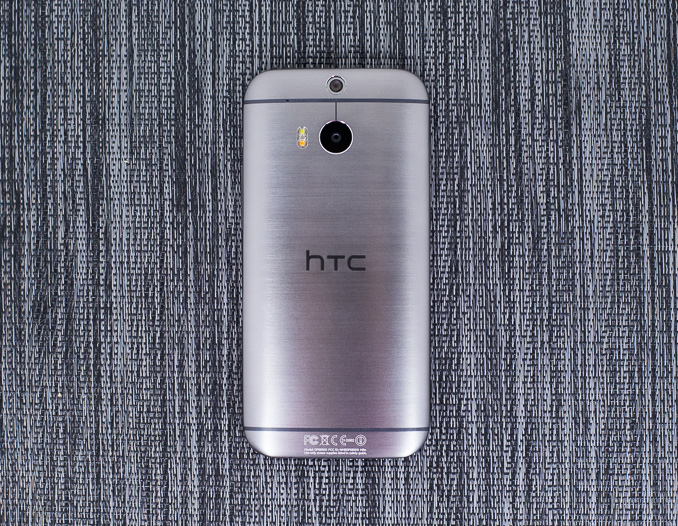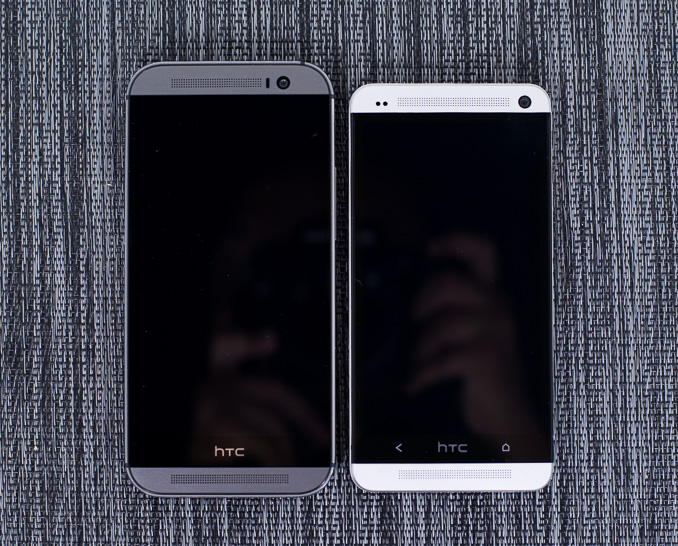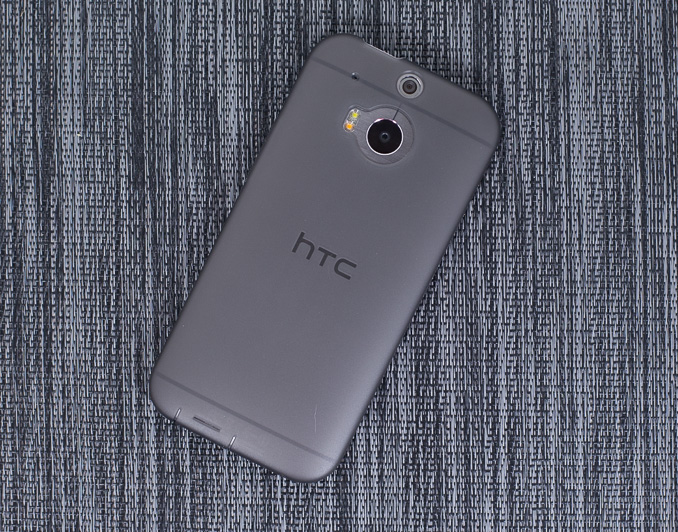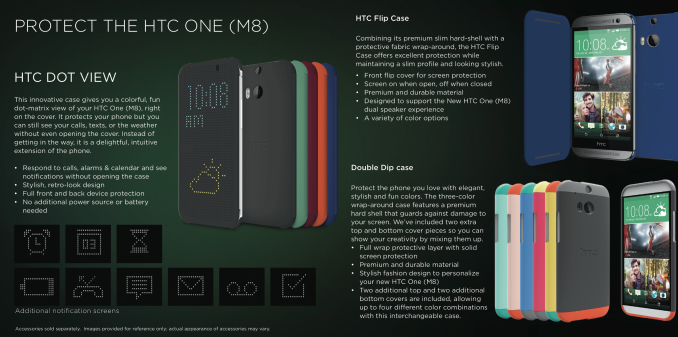The HTC One (M8) Review
by Anand Lal Shimpi & Joshua Ho on March 26, 2014 7:00 PM EST- Posted in
- Smartphones
- HTC
- Mobile
- HTC One

HTC remains one of few Android OEMs insanely focused on design. Even dating back to the origins of the One brand in 2012 with the One X and One S, HTC clearly saw design where others were more focused on cost optimization. Only time will tell which is the more viable long term business strategy, but in the interim we’ve seen two generations of well crafted devices from what would otherwise be thought of as a highly unlikely source. With its roots in the ODM/OEM space, HTC is one of very few ODM turned retail success stories that we’ve seen come out of Taiwan. ASUS is the closest and only real comparison I can make.
As its name implies, the goal of the One brand was to have a device that anyone, anywhere in the world could ask for and know they were getting an excellent experience. Although HTC sort of flubbed the original intent by introducing multiple derivatives (One X, One S, One X+), it was the beginning of relief from the sort of Android OEM spaghetti we saw not too long ago. With the One brand, HTC brought focus to its product line.
Last year HTC took a significant step towards evolving the brand into one true flagship device, aptly named the One. Once again there were derivatives (One mini and One max), but the messaging was far less confusing this time around. If you wanted small you got the mini, if you wanted big you got the max, otherwise all you needed to ask for was the One.
With last year’s One (codenamed M7), HTC was incredibly ambitious. Embracing a nearly all metal design and opting for a much lower resolution, but larger format rear camera sensor, the One was not only bold but quite costly to make. With the premium smartphone market dominated by Apple and Samsung, and the rest of the world headed to lower cost devices, it was a risky proposition. From a product standpoint, I’d consider the M7 One a success. A year ago I found myself calling it the best Android phone I’d ever used.
It didn’t take long for my obsession to shift to the Moto X, and then the Nexus 5, although neither delivered the overall camera experience of the One. Neither device came close to equaling HTC on the design front either, although I maintain Motorola did a great job with in hand feel. Although I found myself moving to newer devices since my time with the One last year, anytime I picked up the old M7 I was quickly reminded that HTC built a device unlike any other in the Android space. It just needed a refresh.
It’s been leaked beyond belief, but in case you haven’t seen it by now this is the M8, the new HTC One:
It’s taller and slightly wider than last year’s model (with a correspondingly larger 5” 1080p display), but all at roughly the same thickness. The all metal chassis is back, but with more metal. If you remove the display and internals, HTC claims the M8 chassis is now 90% metal compared to 70% with the M7. There is a weight impact, but the M8 never feels heavy at 160 grams.
The plastic ring around the M7 is gone, replaced with a single piece of aluminum that curves around the body. With the exception of a strip along the top edge, BoomSound speaker grills and some narrow strips on the back for antennas, the M8 is all metal.
The M8’s surface is a bit smoother than the M7, and there’s now a nice horizontal brushed effect in the gunmetal gray finish. The device is still every bit as wonderful to hold as its predecessor. The design is different, and overall I’d consider it better. For those who care about material feel and design it’s clearly a level above what you see on the market at this price point.
The device will be available in three different colors: Gunmetal Gray (what I was sampled), Glacial Silver and Amber Gold.
HTC also ditched the two fixed capacitive buttons, which was a pain point for some with the M7. Instead we have up to four on-screen buttons at the bottom of the display: back, home, multitasking, and menu as appropriate.
Appearances are meaningless if the device doesn’t have the hardware to back it up, and thankfully the M8 is an upgrade almost entirely across the board. I threw the relevant spec differences into the table below:
| HTC One (2013) | HTC One (M8) | |
| SoC | APQ8064AB 1.7 GHz Snapdragon 600 | MSM8974ABv3 2.3 GHz Snapdragon 801 |
| RAM/NAND | 2 GB LPDDR2, 32/64GB NAND | 2GB LPDDR3, 16/32GB NAND + microSD |
| Display | 4.7” SLCD3 1080p | 5” 1080p LCD |
| Network | 2G / 3G / 4G LTE (Qualcomm MDM9x15 UE Category 3 LTE) | 2G / 3G / 4G LTE (Qualcomm MDM9x25 UE Category 4 LTE) |
| Dimensions | 137.4 x 68.2 x 9.3mm max / 4mm min, 143 grams | 146.36 x 70.6 x 9.35mm max, 160 grams |
| Camera | 4.0 MP (2688 × 1520) Rear Facing with 2.0 µm pixels, 1/3" CMOS size, F/2.0, 28mm (35mm effective), 2.1 MP front facing | 4.0 MP (2688 × 1520) Rear Facing with 2.0 µm pixels, 1/3" CMOS size, F/2.0, 28mm (35mm effective) and rear depth camera, 5MP f/2.0 FFC |
| Battery | 2300 mAh (8.74 Whr) | 2600 mAh (9.88 Whr) |
| OS | Android 4.4 with Sense 5.5 | Android 4.4 with Sense 6 |
| Connectivity | 802.11a/b/g/n/ac + BT 4.0, USB2.0, GPS/GNSS, MHL, DLNA, NFC | 802.11a/b/g/n/ac + BT 4.0, USB2.0, GPS/GNSS, MHL, DLNA, NFC |
| SIM Size | MicroSIM | NanoSIM |
There’s a faster (and more power efficient SoC), a larger battery, and a higher resolution front facing camera. BoomSound gets a new amp and better sounding speakers, there's also a new dual color flash and a well integrated micro SD card slot (one that doesn't require a removable back). If you were pleased with last year’s One, chances are that you’ll be very happy with this one. If, however, you weren’t totally sold on the M7’s 4MP UltraPixel camera there’s a bit of bad news.
The story of last year’s One revolved around HTC’s decision to use a larger format 4MP camera sensor instead of moving to a higher megapixel sensor with smaller pixels. It was a polarizing tradeoff, but one that was somewhat validated by Apple with its choice of maintaining resolution but increasing pixel/sensor size with the 5s. The most obvious fix for those who had issues with the lack of spatial resolution with last year’s One would be to go to a higher resolution sensor, without going as far as Samsung and LG. Unfortunately, without the buying power of a company like Apple, HTC is left to pick from those sensors that are more widely available. In other words, options are limited.
The solution this round was to keep the rear sensor from the M7 (without OIS), and augment it with another rear facing camera module. I’ll get to the use of the second sensor in a bit, but ultimately that’s the going to be the biggest friction point with the new One. Those customers who were happy with the M7’s camera will be pleased this round, but those who wanted a slight bump in spatial resolution will be left wanting more.
Cellular Bands and What’s Launching
I’m aware of seven different M8 SKUs launching today. In the US, AT&T, T-Mobile, Sprint and Verizon are all getting the new HTC One. Verizon had immediate availability in stores 2 hours after launch, while AT&T and Sprint were available online the same day. All three operators should have devices by April 11th. T-Mobile is the exception as it won’t have the M8 in stores until next month.
Google will be taking preorders for the Google Play Edition of the new One today. Despite shipping with GPE Android, HTC claims the GPE M8 will support Duo Cam via HTC’s APIs (perhaps via a modified AOSP camera app?).
As far as I can tell only the AT&T and Google Play Edition SKUs support carrier aggregation. The two SKUs are quite similar from a cellular standpoint, with the AT&T model locking out UMTS band 4 to discourage movement to T-Mobile.
| HTC One (M8) Cellular Band Support | ||||||||
| FCC ID | Operator/Region Target | CDMA Bands | GSM | WCDMA | LTE | CA | ||
| NM80P6B100 | EMEA | - | 850, 900, 1800, 1900 | 850, 900, 1900, 2100 | 3, 7, 8, 20 | - | ||
| NM80P6B120 | AT&T | - | 850, 900, 1800, 1900 | 850, 1900, 2100 | 2, 4, 5, 7, 17 | 4+17, 2+17 | ||
| NM80P6B130 | T-Mobile | - | 850, 900, 1800, 1900 | 850, AWS, 1900, 2100 | 4, 17 | - | ||
| NM80P6B200 | Verizon | 800, 1900 | 850, 900, 1800, 1900 | 850, 900, 1900, 2100 | 4, 7, 13 | - | ||
| NM80P6B700 | Sprint | 800, 1900 | 850, 900, 1800, 1900 | 850, 1900, 2100 | 25, 26, 41 | - | ||
| NM80P6B160 | Canada | - | 850, 900, 1800, 1900 | 850, AWS, 1900, 2100 | 4, 7, 17 | - | ||
| NM80P6B170 | Google Play Edition | - | 850, 900, 1800, 1900 | 850, AWS, 1900, 2100 | 2, 4, 5, 7, 17 | 4+17, 2+17 | ||
With the exception of the Sprint SKU, all of the remaining M8 SKUs feature Qualcomm’s QFE11xx envelop power tracker. In addition, all SKUs with the exception of the T-Mobile and Sprint devices use Qualcomm’s QFE15xx antenna matching tuner. None of the M8s use the CMOS power amps and it’s still too early for the rest of Qualcomm’s RF360 platform. Unfortunately this present refresh comes a little too early for Qualcomm’s next-generation Category 6 LTE 9x35 modem.
Launching with immediate availability in the US and UK, with other regions following in the coming weeks, is an incredibly difficult feat to pull off. It also helps explain why there were so many leaks leading up to today’s launch. The real trick is timing launch availability and sampling so you don’t have operator partners spoiling your launch, but that’s a challenge for another day.
Inside the One’s box you’ll find the usual suspects: earbuds, USB cable and charger. New this round is you’ll find a simple case in your box. The included case is a no frills design, but it’s awesome to find something like that in the box these days.
HTC will gladly sell you one of their Double Dip, Flip or new Dot View cases. The former now includes two sets of top/bottom colors with each case. The Dot View case is interesting as it enables some glance usage models, but without an AMOLED display I’m curious about the power impact.





















222 Comments
View All Comments
Johnmcl7 - Sunday, March 30, 2014 - link
Because there is no such thing as an absolute phone - everyone has different preferences and the market reflects that. I much prefer Samsung's lighter and durable plastic construction which can hold up to daily use and allows a removable battery rather than HTC's heavier metal cases which if used without a case easily pick up scuffs and scratches making them look decidedly second hand within a matter of months.w2aith - Friday, March 28, 2014 - link
Fantastic phone. Good weight, great hand feel. Faster than I expected. Camera is unimpressive, but that is not what i look for in a phone. Sound quality from the speakers on the phone is the best I've heard.Death666Angel - Friday, March 28, 2014 - link
"There’s nothing more to say other than I’m disappointed."Golden! Is it wrong that I read that in my head in Jon Stewart's Jewish Mother voice? :D
Death666Angel - Friday, March 28, 2014 - link
Just finished reading your review.Feeling kinda underwhelmed by the M8. First off, I don't really care about the all metal design of a phone. I can appreciate that for all of 2 seconds before I put a plastic case on it and never see the body again unless it is for cleaning. So that advantage is lost for me. I want to like the camera and I kinda do. But 4MP is too low for me. Decrease pixel size, increase the sensor size a bit and give me 6 or 8. I don't need 13MP at 1.12 (?) um, but 4MP@2um is just not good enough, especially as a follow up to that same camera. I don't do that much low-light photography either, but I've used my SGS2 as a camera on holidays when my point and shoot was low on batteries, so outdoor pictures are very important. Losing OIS is an astonishing move and puzzles me greatly. The 801 is looking pretty cool, the mSD card helps, but those aren't unique features. For the price, the display needs to be calibrated better (although I also don't care much about that). I don't really care about the sound of a phone because my usage model does not involve playing anything without headphones plugged in.
The old M7 is still ~70 to 120€ more expensive than any of its competitors phones (Nexus 5, LG G2, SGS4, Xperia Z, not comparing the same capacities, because I am fine with 16GB on my phone), so I don't think the new M8 will be a price competitive offering. I don't see myself being impressed by the SGS5 either. Note 4 maybe? Haven't heard too much about it. But any smartphone that costs over 400€ needs to offer some serious advantages to get me to consider it instead of a Nexus.
If Nexus 5.2 gets a bigger battery, marginally faster SoC at better power characteristics and a better performing camera (1.4 - 1.7 um with 6 or 8MP image and OIS and a 4 or 5MP front facing camera), I'll be a happy boy and upgrade from my Galaxy Nexus.
tvandegr - Friday, March 28, 2014 - link
Do we know if the Developer edition or the unlocked edition support carrier aggregation? They seem to be based off of the ATT model from what I have seen other places.skylinkdave - Friday, March 28, 2014 - link
You know what's even more fun than a fiddly phone camera? A real camera that's able to do all of this in-camera without all the post.ol1bit - Saturday, March 29, 2014 - link
As always, Anandtech is spot on with the review. Good Job! Just read some of the other reviews for comparison.pdc200 - Saturday, March 29, 2014 - link
Hmmmm so what happened to reviewing things like Call Quality, Boomsound Quality and loudness? Quality of Audio from the Headphone jack?ghm3 - Saturday, March 29, 2014 - link
I've been eagerly awaiting the Sony Xperia Z2 ever since MWC, and this review doesn't change that at all, but at this is clearly my next choice. The addition of a micro SD slot makes this far more appealing to me now.Either way I'm so done with Samsung's cheap garbage loaded with shitware you can't remove without cracking the phone. Beyond the hardware with the Z2 I'm really looking forward to the mostly un-molested Android build on it. Can anyone provide insight into how HTC is in this department?
thisiskicker - Sunday, March 30, 2014 - link
Awesome It has a micro SD card expansion. This is what phones are now a days are missing.